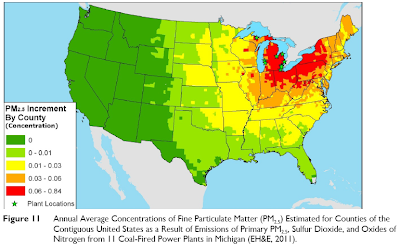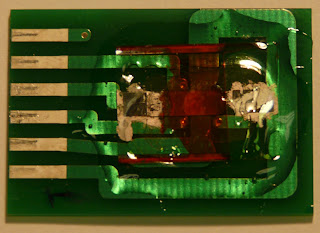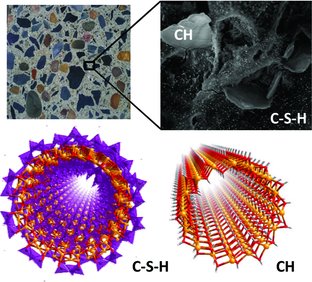Click here to read this mailing online.
|
A Big Shift from Coal to Natural Gas Because of Cheap Natural GasThe share of U.S. electricity that comes from coal is forecast to fall below 40 percent for the year — the lowest level since the government began collecting this data in 1949. Four years ago, it was 50 percent. By the end of this decade, it is likely to be near 30 percent.
Utilities are aggressively ditching coal in favor of natural gas, which has become cheaper as supplies grow. Natural gas has other advantages over coal: It produces far fewer emissions of toxic chemicals and gases that contribute to climate change, key attributes as tougher environmental rules go into effect. The shift is because shale gas has increased supplies and made natural gas cheap. It is not because of concerns over health effects. Coal is more harmful for health. Read more » Air Pollution by Location and Incremental Effect from Coal PlantsThis is an update of air pollution from coal plants in the United States.

Map of coal power by state. Note: about of third of the air pollution can go thousands of miles from the plant. There is more impact on air quality and health of those near the plants. Air pollution has been improved in the USA since the 1950s and 1960s. There is still a negative effect. 24,000 coal impacted deaths and a total of 60,000 air pollution impacted deaths out of 2.5 million deaths from any cause. Cigarette smoking and obesity have larger negative effects, which is seen in West Virginia's health statistics. The bad air pollution states are ending up at or near the bottom of state health rankings. The incremental particulate matter from 11 coal plants in Michigan They have mapped the health effects from particulates from all coal plants based on the measurement of incremental pollution by location. They have the increased levels of health impacts in those same locations. PM2.5 is 10-12% from coal power plants. So it is not the whole problem but eliminating that pollution source would improve health and save lives. Analysis of PM10 by metro statistical area. Source watch has a list of the states with the most coal power plants Rank State # of Plants Total Capacity 2005 Power Prod. 1 Texas 20 21,238 MW 148,759 GWh 2 Ohio 35 23,823 MW 137,457 GWh 3 Indiana 31 21,551 MW 123,985 GWh 4 Pennsylvania 40 20,475 MW 122,093 GWh 5 Illinois 32 17,565 MW 92,772 GWh 6 Kentucky 21 16,510 MW 92,613 GWh 7 West Virginia 19 15,372 MW 91,601 GWh 8 Georgia 16 14,594 MW 87,624 GWh 9 North Carolina 25 13,279 MW 78,854 GWh 10 Missouri 24 11,810 MW 77,714 GWh 11 Michigan 33 12,891 MW 71,871 GWh 12 Alabama 11 12,684 MW 70,144 GWh 13 Florida 15 11,382 MW 66,378 GWh 14 Tennessee 13 10,290 MW 59,264 GWh 15 Wyoming 10 6,168 MW 43,421 GWh 16 Wisconsin 28 7,116 MW 41,675 GWh Read more » A ‘Dirt Cheap’ Magnetic Field Sensor from ‘Plastic Paint’University of Utah physicists developed an inexpensive, highly accurate magnetic field sensor for scientific and possibly consumer uses based on a “spintronic” organic thin-film semiconductor that basically is “plastic paint.”
The new kind of magnetic-resonance magnetometer also resists heat and degradation, works at room temperature and never needs to be calibrated, physicists Christoph Boehme, Will Baker and colleagues report online in the Tuesday, June 12 edition of the journal Nature Communications. An inexpensive and highly accurate “spintronic” magnetic field sensor developed at the University of Utah is shown here. The entire device, on a printed circuit board, measures about 0.8 inches by 1.2 inches. But the part that actually detects magnetic fields is the reddish-orange thin-film semiconductor – essentially “plastic paint” – near the center-right of the device. Photo Credit: Christoph Boehme, University of Uta Nature Communications - Robust absolute magnetometry with organic thin-film devices Read more » Quantum computers could help search engines keep up with the Internet's growthEurekalert - USC scientists demonstrate that quantum computing could speed up the way web page ranks are calculated on the ever-expanding Internet.
Most people don't think twice about how Internet search engines work. You type in a word or phrase, hit enter, and poof – a list of web pages pops up, organized by relevance. Read more » 1 nanometer diameter wires could yield next gen quantum computersNew Electronics UK - Nanowires can now be made with a diameter of just 1 nanometer (nm), though researchers tend to work with nanowires that are between 30 and 60nm wide. At these dimensions, materials can acquire properties very different to those they exhibit at larger scales. That is partly because at such tiny scales, quantum confinement effects alter the behaviour of fundamental particles like electrons within the material. Such effects can change how materials conduct electricity and heat, or interact with light.
"There are a host of niche applications within the electronics sector, such as solar cells and sensors, where nanowires could have a significant impact in the medium term and rapid advances are being made. You could say nanowires have taken on some of the attention that a few years ago was being spent on nanotubes."Read more » Sandia aberration-corrected scanning transmission electron microscope is 50 to 100 times faster and 50 times better resolutionSandia’s new aberration-corrected scanning transmission electron microscope (AC-STEM), the $3.2 million FEI Titan G2 8200, is 50 to 100 times better than what came before, both in resolution and the time it takes to analyze a sample.
The AC-STEM delivers electron beams accelerated at voltages from 80 kV to 200 kV, allowing researchers to study properties of structures at the nanoscale — crucial for materials scientists working on everything from microelectronics to nuclear weapons. The image on the left was captured in seven minutes at 0.5nm/pixel with Sandia's new AC-STEM; the image on the right was captured in 120 minutes at 2nm/pixel with the old microscope. The analytical power of the AC-STEM is at least 70 times better than the older analytical microscope at Sandia. These high-resolution chemical images are confirming predictions from the 1970s regarding the atomic-scale characteristics of electrical contact materials. (Image courtesy of Sandia National Laboratories) Read more » Singapore sets up US$11.7 million Graphene Product Fabrication FacilityChannelnewsasia - The National University of Singapore's Graphene Research Centre announced on Tuesday the opening of a S$15 million micro- and nano-fabrication facility to produce graphene products.
The facility is the first of its kind in Asia and will be fully operational by October. Read more » Atomistic Simulations Show Cement Nanotubes Can ExistAdvanced Materials Journal - Using atomistic simulations, this work indicates that cement nanotubes can exist. The chemically compatible nanotubes are constructed from the two main minerals in ordinary Portland cement pastes, namely calcium hydroxide and a calcium silicate hydrate called tobermorite. These results show that such nanotubes are stable and have outstanding mechanical properties, unique characteristics that make them ideally suitable for nanoscale reinforcements of cements.
Nanowerk has coverage The problem with carbon nanotubes is that they are water insoluble. In order to make them compatible with water chemistry, they must be functionalized in advance. Inorganic oxide nanotubes would be a natural means of reinforcements of cement pastes, in view of their chemically compatibility with the cement-water system. The team focused on cement-based nanotubes fabricated from calcium silicate hydrate gel and calcium hydroxide precipitates. They succeeded in demonstrating the feasibility of these cement nanotubes in view of their stability at room temperature, with strain energies in agreement with values previously obtained for other nanotubes compounds. Read more » $39 Raspberry Pi has better hardware and Emulates the Software of old IBM Mainframe and DEC VAX ClusterDesign Spark - a Raspberry Pi ($39) can be used to emulate a mainframe which would have filled a large computer room, and to run the same software which it would have run. Of course, the only reason you would do this is for fun, learning or perhaps as part of computer conservation efforts, e.g. in providing continued access to old computer software and/or data. A modern mainframe would massively outperform a Raspberry Pi and offer many benefits beyond simple processing power.
Having configured a mainframe on a Raspberry Pi, it was time to try out a Raspberry Pi on a mainframe! The image below shows the Pi sat on top (centre) of the CPU from an IBM 4381. Read more » 208 million annual shipments of Phone/Tablet Hybrids by 2015ABI Research - More than 208 million phablets, a hybrid device that is larger than a smartphone but smaller than a tablet, like the Samsung Galaxy Note, will be shipped globally in 2015. The category includes smartphones and tablet devices in the 4.6 to 5.5 inch screen size range.
We recently covered the Samsung Galaxy S3 (4.8 inch screen) and the expected Samsung Galaxy Note 2 (5.5 inch screen) Despite the slow start for phablet smartphones in 2011, the market is at the dawn of the phablet era. HTC, LG, and Huawei will each introduce phablet smartphones in 2012, joining the ranks of Samsung’s Galaxy Note and Nexus. The 5.3 inch Galaxy Note beside an iPhone 4S By ABI Research’s definitions, many recent Android smartphones would fall into the ‘phablet’ category, such as the LG Optimus Vu, HTC One X, the HTC One XL on ATT, the HTC EVO 4G LTE on Sprint, the Samsung Galaxy Nexus, and the Samung Galaxy S III. Gigaom - With rich media consumption on the rise on mobile devices — particularly as we get faster 4G networks and more Wi-Fi networks to supplement them — a larger display is desirable. The same can be said for Web browsing, which is one of the most popular activities on a mobile: Why scroll and zoom when a larger display minimizes such efforts? Read more » More Recent Articles |










